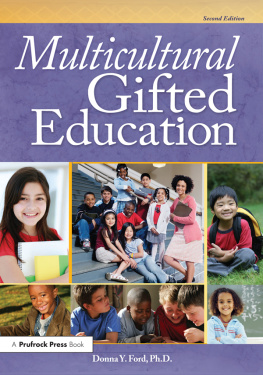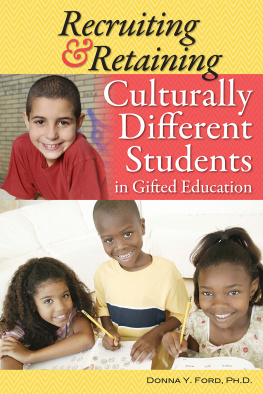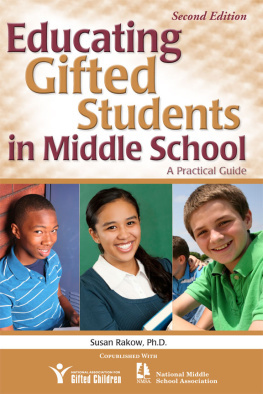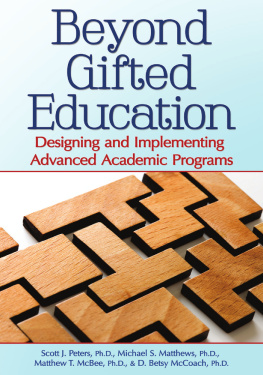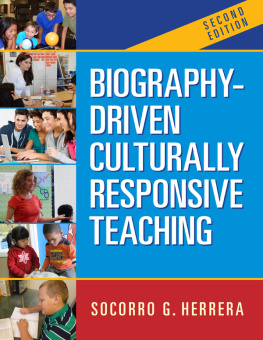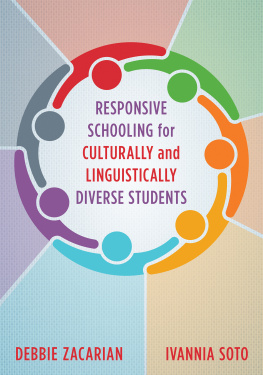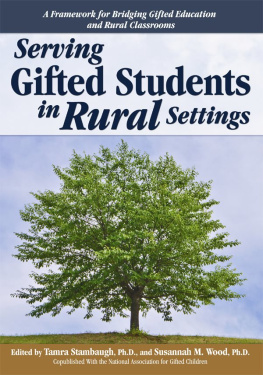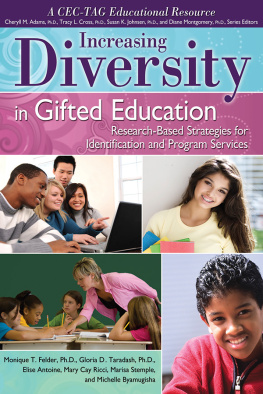I am grateful to all of the individuals in my lifepersonal and professionalwho have contributed to my development as an educator, scholar, and human being. My list of people to thank is long, so I cannot list them all. My mother, a strong, intelligent, and resourceful lady, has been my role model and unrelenting advocate. No one means as much to me as my son Khyle. He and I personify the strong and unconditional love that exists between a mother and son. Khyle and my familymy mother, two sisters, three nieces, a nephew, and their childrenhave been my source of inspiration, as have all of the students (pre-K12 and college) and equity-minded educators with whom I have worked. I also wish to acknowledge the scholarship of my colleagues who fight with me to desegregate gifted educationTarek Grantham, Deborah Harmon, and Michelle Trotman Scott. It is good to have company in this worthy fight! I also want to say thank you to my significant otherhe knows to whom I am referring. I am thrilled to add to the overdue and much-needed discussion on how education should, can, and must promote pride, share multiple perspectives, and be a catalyst for change and social justicefor all students, for all schools, and for society at large!
APPENDIX A
Sample Multicultural Activities: Preinstruction or Reinforcement Exercises
The exercises below are useful preinstruction and reinforcement multicultural activities. However, they cannot stand alone as strategies for integrating culturally responsive education into traditional curriculum and instruction.
- Make a book entitled We All Look Special about the physical characteristics of each child. Take color photos of each child and place each on its own page. Ask students to describe themselves and write what they say under the photo. Include skin color, hair, and eyes among the characteristics. When the book is complete, read it to students at circle time or some other time designated for group reading.
- As part of science, talk about skin and melanin, along with their functions. It might be helpful to provide students with skin-colored crayons. Help students to choose the crayon closest to their skin color and then draw pictures of themselves. In some instances, students may want to mix colors for painting pictures of themselves. Be creative and positive in talking about the beauty of each shade. Relative to skin tones, students can read All the Colors of the Race (Adoff, 1982) and Black Is Brown Is Tan (Adoff, 1973). Similarly, students can read Colors Around Me (Church, 1971), which illustrates the variations of skin shades among racially and culturally different children. It also emphasizes how they are all members of the same family of African Americans. This book can be used to help children explore the concept that people with different shades are still considered members of the same group. Have students to make their own Colors Around Me book after reading works such as Planting a Rainbow (Ehlert, 1988). Read Black Is Beautiful (McGovern, 1969) and have children make a list of beautiful black, brown, and other colored objects. Make sure children use browns, blacks, and other tones in their artwork, play dough, paints, and so forth. Encourage positive feelings about brown and black. Talk with students about how colors are used in negative ways and how to substitute the colors for other words (e.g., Black sheep, dark mood, blackmail, blackball, in the red). Have them analyze the media for the use of these words in negative and positive ways. Students can write letters to newspaper editors, TV shows, and the like, expressing their findings and concerns.
- Read childrens books about families that reflect the ethnic groups in your class. Always read more than one book about each culture. Talk about similarities and differences. Ask children to share, if they are comfortable, how they are different from or similar to what is presented in the book. It may be helpful to have children locate and share the books that they prefer with classmates.
- Make sure that toys and objects in dramatic play come from different cultures (e.g., dolls, clothes, woks, bongo drums, tangrams, chopsticks). Demonstrate how the objects are used and provide background information on them. Have children bring in and share items that are meaningful to them and their families. Teachers can bring in objects from home to set the tone and model what is expected.
- Display different writing systems (e.g., Hebrew, Swahili, Chinese) and label materials in more than one language. Teach children how to write a few letters and their names in the different alphabets. For example, students can read Jambo Means Hello (Feelings, 1992a) and Moja Means One (Feelings, 1992b). Read children stories in different languages and ask them to help translate them. Further, read books with children that challenge stereotypes.
- Read books about the beauty of black hair, such as Cornrows (Yarbrough, 1997) and Honey, I Love (Greenfield, 2002). In a class with racially and culturally different students, these books nurture self-pride; in a class without racially and culturally different students, the books increase childrens awareness of diversity.
APPENDIX B
Multicultural Education Program Evaluation Guidelines and Checklist
| 1.0 | Does ethnic and cultural diversity permeate the total school envi-ronment? |
| 1.1 | Are ethnic content and perspectives incorporated into all aspects of the curriculum, preschool through 12th grade and beyond? |
| 1.2 | Do instructional materials treat racial and ethnic differences and groups honestly, realistically, and sensitively? |
| 1.3 | Do school libraries and resource centers offer a variety of materials on the histories, experiences, and cultures of many racial, ethnic, and cultural groups? |
| 1.4 | Do school assemblies, decorations, speakers, holidays, and heroes reflect racial, ethnic, and cultural group differences? |
| 1.5 | Are extracurricular activities multiethnic and culturally responsive? |
| 2.0 | Do school policies and procedures foster positive interactions among the various racial, ethnic, and cultural groups in the school? |
| 2.1 | Do school policies accommodate the behavioral patterns, learning styles, and orientations of the ethnic and cultural group members actually in the school? |
| 2.2 | Does the school provide a variety of instruments and techniques for teaching and counseling students of various ethnic and cultural groups? |
| 2.3 | Do school policies recognize the holidays and festivities of variousethnic groups? |
| 2.4 | Do school polices avoid instructional and guidance practices based onstereotypes and ethnocentric perceptions? |
| 2.5 | Do school policies respect the dignity and worth of students asindividuals and as members of racial, ethnic, and cultural groups? |
| 3.0 | Is the school staff (administrators, instructors, counselors, and support staff) multiethnic and culturally responsive? |
| 3.1 | Has the school established and enforced policies for recruiting andmaintaining a staff made up of individuals from various racial andethnic groups? |
| 4.0 | Does the school have systematic, comprehensive, mandatory, and continuing multicultural staff development programs? |
| 4.1 | Are teachers, librarians, counselors, administrators, and support staffincluded in the staff development programs? |
| 4.2 | Do the staff development programs include a variety of experiences (e.g., lectures, field experiences, curriculum projects)? |

